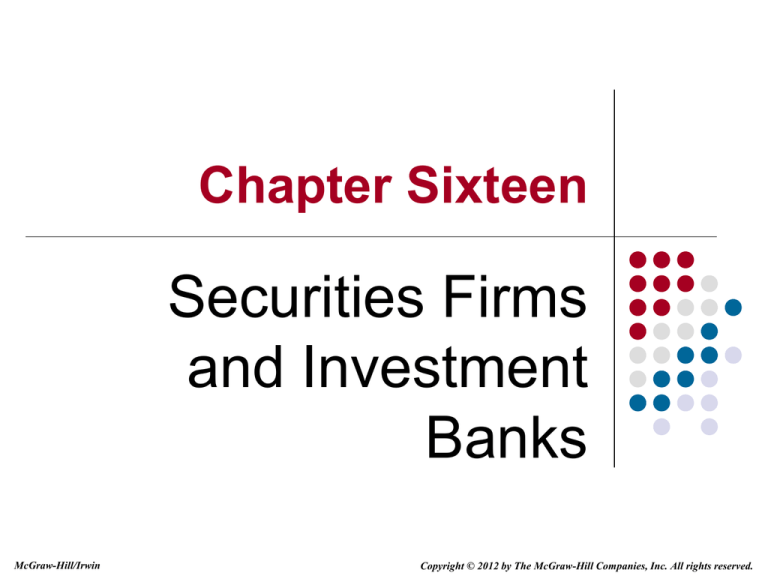
Chapter Sixteen
Securities Firms
and Investment
Banks
McGraw-Hill/Irwin
Copyright © 2012 by The McGraw-Hill Companies, Inc. All rights reserved.
Securities Firms and Investment
Banks (IBs)
Investment banks (IBs) help corporations and
governments raise capital through debt and equity
security issues in the primary market
underwriting is assisting in the issue of new securities
IBs also advise on mergers and acquisitions (M&As) and
corporate restructuring
Securities firms assist in the trading of securities
in secondary markets
broker-dealers assist in the trading of existing securities
16-2
Securities Firms and Investment
Banks (IBs)
The size of the industry is usually measured by the equity
capital of firms rather than total asset size
The number of firms in the industry changed due to
economies of scale and scope, losses with the economy,
scandals at some firms, and regulations that allowed both
inter- and intra-industry mergers
Equity capital in the industry in 2010 was $214.5 billion
5,248 firms in 1980
9,515 firms in 1987
5,063 firms in 2010
As with commercial banks, consolidation has largely
occurred through mergers and acquisitions
16-3
Securities Firms and Investment
Banks (IBs)
Commercial bank holding companies that operate
diversified national full-line firms
service both retail and wholesale customers by acting as
broker-dealers
service corporate customers by underwriting security
issues
National full-line firms specializing in corporate finance
The second largest group of firms are full-service firms
that specialize in corporate finance or primary market
activity (i.e., focus less on secondary market activities)
16-4
Securities Firms and Investment
Banks (IBs)
Large investment banks
Have only limited branch networks concentrated in major cities
and service primarily financial institution clients
Smaller specialized firms such as:
regional investment bankers (sometimes labeled ‘boutiques’)
discount brokers
Internet brokers
venture capital firms
exchange floor specialists
dealers in off exchange trading
16-5
Lines of Business
Investment banking
first time debt and equity issues occur through initial
public offerings (IPOs)
new issues from a firm whose debt or equity is already
traded are called seasoned equity offerings (SEOs)
a private placement is a securities issue that is placed
with one or a few large institutional investors
public offerings are offered to the public at large
IBs act only as an agent in best efforts underwriting
IBs act as principals in firm commitments
16-6
Lines of Business
Venture capital (VC) is a professionally managed
pool of money used to finance new (i.e., start-up)
and often high-risk firms
VC usually purchases an equity stake in the start-up
usually become active in management of the start-up
institutional venture capital firms find and fund the most
promising new firms
venture capital limited partnerships
financial venture capital firms
corporate venture capital firms
16-7
Lines of Business
Private equity investments
Private equity (PE) differs from VC in funds sources and in
types of investments
PE firms raise funds by selling securities rather
than commingling private funds
PE firms often acquire established existing firms
rather than purchase start-ups
16-8
Lines of Business
Market making involves the creation of secondary
markets for an issue of securities
agency transactions are two-way transactions on behalf
of customers
with principal transactions market makers seek to profit
for their own accounts
Investment banks managed $88 trillion in derivatives
securities in 2010
16-9
Lines of Business
Trading involves taking an active net position in an
asset
Position trading involves relatively long-term positions in
assets
Pure arbitrage involves attempts to profit from price
discrepancies
Risk arbitrage involves attempts to profit by forecasting
information releases
Program trading is the simultaneous buying and selling
of at least 15 different stocks valued at $1 million or more
16-10
Lines of Business
Trading (continued)
Stock brokerage involves trading on behalf of customers
Electronic brokerage offers customers direct access, via
the internet, to the trading floor
16-11
Lines of Business
Investing involves managing pools of assets such
as closed- and open-end mutual funds
as agents
as principals
Cash management involves deposit-like accounts
such as money market mutual funds (MMMFs) that
offer check writing privileges
16-12
Lines of Business
Merger and acquisition (M&A) assistance
M&A activity by year
US
Global
2008
$924 billion
$2.85 trillion
2009
713
1.70
2010*
452
1.28
* First nine months
M&A activity brings large fees to bankers
M&A business remains very cyclical and depends on the
economy
16-13
Lines of Business
Other Service Functions
Security custodian services
Clearance and settlement services
Escrow services, research and advice on divestitures, and
asset sales
16-14
Industry Performance
Industry trends depend heavily on the state of the
stock market and the economy
Commission income fell after the 1987 stock market crash
and the 2001-2002 stock market decline
Improvements in the U.S. economy in the mid-2000s led
to increases in commission income but income fell with the
stock market in 2006-2008 because of rising oil prices and
the subprime mortgage collapse
16-15
Industry Performance
Performance (continued)
Revenues and profits fell record amounts in 2008, but
rebounded sharply in 2009
Industry employment fell sharply
Low interest rates and strong stock market helped fuel
profit recovery
16-16
Balance Sheets of Securities
Firms and Investment Banks (IBs)
Selected Major Assets (2010)
Receivables from other broker-dealers
Long positions in securities and commodities
Reverse repurchase agreements
33.79%
26.54%
26.40%
16-17
Balance Sheets of Securities
Firms and Investment Banks (IBs)
Selected Major Liabilities and Equity (2010)
Payables to other broker-dealers
14.25%
Payables to customers
13.35%
Short positions in securities and commodities
10.29%
Repurchase agreements
40.82%
Other non-subordinated liabilities
9.80%
Equity
4.94%
(SEC requires minimum net worth to assets of 2%)
16-18
Regulation of Securities Firms
and Investment Banks (IBs)
The Securities and Exchange Commission
(SEC) is the primary regulator of the securities
industry
The National Securities Markets Improvement
Act (NSMIA) of 1996 reaffirmed federal (over state)
authority
Even so, state attorneys generally intervene through
securities-related investigations that have led to many
highly publicized criminal cases
16-19
Regulation of Securities Firms
and Investment Banks (IBs)
The Sarbanes-Oxley Act (SOX) of 2002
created an independent auditing oversight board
under the SEC
increased penalties for corporate wrongdoers
forced faster and more extensive financial
disclosure
created avenues of recourse for aggrieved
shareholders
16-20
Regulation of Securities Firms
and Investment Banks (IBs)
The SEC sets rules governing underwriting
and trading activity
SEC Rule 144A defines boundaries between
public offerings and private placements
16-21
Regulation of Securities Firms
and Investment Banks (IBs)
Two self-regulatory organizations oversee the
day-to-day regulation of trading practices
the New York Stock Exchange (NYSE)
the Financial Industry Regulatory Authority (FINRA)
The U.S.A. Patriot Act became effective in 2003
firms must verify identities of customers
firms must maintain records of identities of customers
firms must verify customers are not on suspected terrorist
lists
16-22
Regulation of Securities Firms
and Investment Banks (IBs)
Investors in the industry are protected by the
Securities Investor Protection
Corporation (SIPC)
protects investors against losses of up to $500,000 due to
securities firm failures (but not against poor investment
decisions)
created following passage of the Securities Investor
Protection Act in 1970
16-23
Regulation of Securities Firms
and Investment Banks (IBs)
Under the Dodd-Frank Act, the Financial Services Oversight
Council (FSOC) has oversight of systemic risk of the industry
More investment advisors will have to be registered with
either the SEC or state advisors
Securitization markets should now have more oversight and
originators will have to retain a greater interest in loans that
will be resold
More derivatives regulation is expected as well
16-24
Regulation of Securities Firms
and Investment Banks (IBs)
The government can also mandate higher capital
requirements for larger and for interconnected firms
Conclusion: Government oversight of industry practices has
increased as a result of the bill
16-25
Regulation of Securities Firms
and Investment Banks (IBs)
Executive compensation restrictions imposed by the Obama
administration
Strengthen the independence of the compensation
committee from senior management
Shareholders now also have a non-binding vote on
executive compensation packages
Administration has a say on executive pay for firms that
accepted bailout money
16-26
Global Issues
Securities firms and investment banks are by far the
most global of any group of financial institutions
U.S. firms are increasingly looking to expand their
business abroad—particularly into China and India
Increase in cross-border strategic alliances
16-27










